Demographics, Utilization, Workflow, and Outcomes Based on Observational Data From the RSNA-ACR 3D Printing Registry
IF 4
3区 医学
Q1 RADIOLOGY, NUCLEAR MEDICINE & MEDICAL IMAGING
引用次数: 0
Abstract
Purpose
The aim of this study was to report data from the first 3 years of operation of the RSNA-ACR 3D Printing Registry.
Methods
Data from June 2020 to June 2023 were extracted, including demographics, indications, workflow, and user assessments. Clinical indications were stratified by 12 organ systems. Imaging modalities, printing technologies, and numbers of parts per case were assessed. Effort data were analyzed, dividing staff members into provider and nonprovider categories. The opinions of clinical users were evaluated using a Likert scale questionnaire, and estimates of procedure time saved were collected.
Results
A total of 20 sites and 2,637 cases were included, consisting of 1,863 anatomic models and 774 anatomic guides. Mean patient ages for models and guides were 42.4 ± 24.5 years and 56.3 ± 18.5 years, respectively. Cardiac models were the most common type of model (27.2%), and neurologic guides were the most common type of guide (42.4%). Material jetting, vat photopolymerization, and material extrusion were the most common printing technologies used overall (85.6% of all cases). On average, providers spent 92.4 min and nonproviders spent 335.0 min per case. Providers spent most time on consultation (33.6 min), while nonproviders focused most on segmentation (148.0 min). Confidence in treatment plans increased after using 3-D printing (P < .001). Estimated procedure time savings for 155 cases was 40.5 ± 26.1 min.
Conclusions
Three-dimensional printing is performed at health care facilities for many clinical indications. The registry provides insight into the technologies and workflows used to create anatomic models and guides, and the data show clinical benefits from 3-D printing.
根据 RSNA-ACR 3D 打印注册中心的观察数据得出的人口统计学、使用情况、工作流程和结果。
目的:报告 RSNA-ACR 3D 打印注册中心运行头三年的数据:报告 RSNA-ACR 3D 打印注册中心运行头三年的数据:方法:提取 2020 年 6 月至 2023 年 6 月的数据,包括人口统计学、适应症、工作流程和用户评估。临床适应症按 12 个器官系统进行了分层。对成像方式、打印技术和每个病例的部件数量进行了评估。对工作量数据进行了分析,将工作人员分为提供者和非提供者两类。通过李克特量表问卷评估了临床用户的意见,并收集了节省的手术时间估计数:结果:共纳入了 20 个地点和 2,637 个病例,包括 1,863 个解剖模型和 774 个解剖指南。模型和导板的患者平均年龄分别为(42.4 ± 24.5)岁和(56.3 ± 18.5)岁。心脏模型是最常见的模型类型(27.2%),神经导板是最常见的导板类型(42.4%)。材料喷射、大桶光聚合和材料挤压是最常用的打印技术(占所有病例的 85.6%)。每个病例,医疗服务提供者平均花费 92.4 分钟,非医疗服务提供者平均花费 335.0 分钟。医疗服务提供者花费最多的时间是咨询(33.6 分钟),而非医疗服务提供者花费最多的时间是分割(148.0 分钟)。使用 3D 打印技术后,对治疗计划的信心增加了(p 结论:医疗机构在许多临床适应症中都使用了 3D 打印技术。登记册提供了对用于创建解剖模型和指南的技术和工作流程的深入了解,数据显示了 3D 打印带来的临床益处。
本文章由计算机程序翻译,如有差异,请以英文原文为准。
求助全文
约1分钟内获得全文
求助全文
来源期刊

Journal of the American College of Radiology
RADIOLOGY, NUCLEAR MEDICINE & MEDICAL IMAGING-
CiteScore
6.30
自引率
8.90%
发文量
312
审稿时长
34 days
期刊介绍:
The official journal of the American College of Radiology, JACR informs its readers of timely, pertinent, and important topics affecting the practice of diagnostic radiologists, interventional radiologists, medical physicists, and radiation oncologists. In so doing, JACR improves their practices and helps optimize their role in the health care system. By providing a forum for informative, well-written articles on health policy, clinical practice, practice management, data science, and education, JACR engages readers in a dialogue that ultimately benefits patient care.
 求助内容:
求助内容: 应助结果提醒方式:
应助结果提醒方式:


